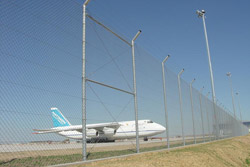New sensor cable enables remote monitoring of miles of perimeter fen

Scientists from Saarland University have developed a special sensor technique to keep safety fence under surveillance. Foto: GBA-Panek GmbH<br>
Up until now, the sheer length of the perimeter to be protected and the high costs involved made this sort of protection impossible at many sites. Working in collaboration with a number of companies, research scientists at Saarland University have developed a new type of surveillance technology that enables extended perimeters to be monitored and protected at low cost.
The new technology is based on magnetometers (magnetic field sensors) that can be incorporated within smart cables of essentially any length. These cables can themselves be installed into fencing or roadways.
The research team is presenting its innovative technology at the major international technology fair Hannover Messe from April 8th to April 12th (Stand C 40, Hall 2 ‒ Saarland Research and Innovation Stand).
If an intruder wants to gain access to a secure industrial site, he first has to overcome some sort of physical barrier, typically a fence. If he climbs the fence or cuts the links he will, unavoidably, cause a vibrational disturbance, which will disclose his position to the novel detection system that has been developed by Uwe Hartmann, Professor for Experimental Physics at Saarland University, and research assistant Haibin Gao. No matter how small the disturbance, each movement of the fence influences the Earth's magnetic field and these changes are detected by the system's tiny, highly sensitive magnetometers.
The magnetometer probes are arranged within the cable like beads on a necklace and the cable is incorporated either permanently or temporarily into the fence. The cable can also be buried in the ground, in which case it responds to any changes in the magnetic field above it. The tiny probes form part of a bus communication network and immediately report any physical disturbance or change including information on where the vibration occurred and whether or not the change in the magnetic field was caused by a human intruder.
The researchers need to be able to exclude false alarms triggered by wind, animals or some other harmless cause. This they do by using complex algorithms to analyse the signals generated by the individual sensors. These algorithms are currently being developed and refined in order to unambiguously distinguish natural disturbances from the disturbances caused by a human intruder.
“The smart sensor cable does not require any major conversion work to be carried out before it can be used, and makes barbed wire and camera surveillance superfluous,” says Professor Hartmann. “The system does not record any personal data. The sensors report only the information that is needed for protecting property or for monitoring, say, rail traffic: Has a disturbance occurred? If it has, where did it occur and was it caused by human interference? No other information about the person is recorded,” explains Hartmann.
The prototype of the “Vibromag Cable” that Uwe Hartmann and his team developed in conjunction with St. Ingbert-based company Votronic Technology GmbH is now to be developed to production standard. This is the objective of a new project starting in August 2013 in which the Saarbrücken physicists will be teaming up with three partner companies, each of which became aware of the new technology at the 2012 Hannover Messe. The three companies are: Sensitec GmbH, based in Mainz and Lahnau (www.sensitec.com), Listec GmbH from Isen (www.listec-gmbh.com), and GBA-Panek GmbH whose headquarters are in Kahla, south of Jena (www.gba-panek.de).
The Saarland Research and Innovation stand at Hannover Messe is organized by Saarland University's Contact Centre for Technology Transfer (KWT).
For further information, please contact:
Prof. Dr. Uwe Hartmann, Nanostructure Research and Nanotechnology Group,
Department of Experimental Physics, Saarland University, Germany
Tel.: +49 (0)681 302-3799 or -3798; E-mail: u.hartmann@mx.uni-saarland.de
Press photographs are available at www.uni-saarland.de/pressefotos and can be used at no charge. Please read and comply with the conditions of use.
Note for radio journalists: Studio-quality telephone interviews can be conducted with researchers at Saarland University using broadcast audio IP codec technology (IP direct dial or via the ARD node 106813020001). Interview requests should be addressed to the university’s Press and Public Relations Office (+49 (0)681 302-3610).
Media Contact
More Information:
http://www.uni-saarland.deAll latest news from the category: HANNOVER MESSE
Newest articles

First-of-its-kind study uses remote sensing to monitor plastic debris in rivers and lakes
Remote sensing creates a cost-effective solution to monitoring plastic pollution. A first-of-its-kind study from researchers at the University of Minnesota Twin Cities shows how remote sensing can help monitor and…

Laser-based artificial neuron mimics nerve cell functions at lightning speed
With a processing speed a billion times faster than nature, chip-based laser neuron could help advance AI tasks such as pattern recognition and sequence prediction. Researchers have developed a laser-based…

Optimising the processing of plastic waste
Just one look in the yellow bin reveals a colourful jumble of different types of plastic. However, the purer and more uniform plastic waste is, the easier it is to…



